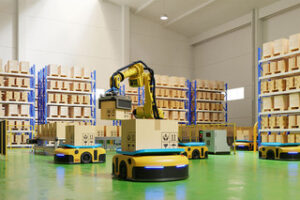 As a new series of Rucha Yantra’s blogs begins, we will delve into Robotics in Warehouse Management. We hope you find it useful.
As a new series of Rucha Yantra’s blogs begins, we will delve into Robotics in Warehouse Management. We hope you find it useful.
Using robotics in warehouse management is transforming how companies store and retrieve goods. The main motives behind doing so are improving efficiency and reducing costs.
Robotic technology offers a range of benefits, from reducing human labor to increasing accuracy and speed in order fulfillment. This article will focus on the benefits of adopting robotics in the warehouse and its historical evolution.
History: The first use
The use of robots in warehouses has been in practice since the 1960s. This is when Unimate, one of the first industrial robots, was used in a General Motors factory. This robot was used to lift and move heavy automobile parts, and it also marked the beginning of the use of robots in manufacturing.
In the following decades, robots were used, majorly, in manufacturing plants. But, their use in warehouses began to increase in the 1990s. The introduction of automated storage and retrieval systems (ASRS) in warehouses was a significant step forward in developing robotics in warehouse management. These systems used robots to move and retrieve products from storage leading to improved efficiency and accuracy.
Over the years, the complexity of robots has increased, and they can perform far more complex functions, making the job of warehouse manager further easier. Such complexity has been possible due to the development of complimenting technologies such as Machine Learning and AI.
Today, many industries, including retail, manufacturing, distribution, etc., deploy robots in their warehouses.
The Amazon fulfillment center is one of the most significant examples of robotics in warehouse management. Amazon uses robots to help pick and pack items for shipment, increasing efficiency and reducing labor costs.
The Benefits
The use of robotics in warehouse management offers a range of benefits, including:
- Improved efficiency: Robots can perform tasks such as moving products and picking items much faster than humans. This increases the efficiency of warehouse operations.
- Reduced labor costs: By automating tasks that humans did, warehouse robots can reduce the need for labor and lower labor costs.
- Increased accuracy: Robots can be easily programmed to perform tasks with high precision. This can reduce the risk of errors and improve accuracy.
- Flexibility: Robots can be easily reprogrammed to perform new tasks as needed. This allows warehouse operations to adapt and change quickly.
- Scalability: Scaling is easily achieved as required (increase/decrease) when using robotics. This makes it easy for companies to adjust their operations as their business grows or changes.
Conclusion
According to a report from the Boston Consulting Group, the use of robots in warehouses is set to increase by 25% by 2025, and the global market for warehouse robots is expected to touch $260 billion by 2030. Given the many benefits robots offer in warehouse management, the above trends shall surely come true.
Rucha Yantra’s Automated Guided Vehicles are designed for the automatic and efficient pick-and-place of material on the shop floor and in warehouses. Check out our range of AGVs here.
Stay tuned to Rucha Yantra’s Knowledge Corner as we discuss robotics in warehouse management in our upcoming blogs.


